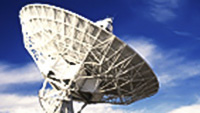Search and order online
Saturn's moon Enceladus hides salt water beneath surface
- Video Tape only
- Title Saturn's moon Enceladus hides salt water beneath surface
- Released: 19/03/2009
- Language English
- Footage Type
- Copyright ESA
- Description
Salt in Enceladus
Saturn's moon hides salt water
Format 16:9
Saturn's moon Enceladus may be harbouring pre-biotic processes! A European instrument team on the joint ESA-NASA Cassini-Huygens mission to the ringed planet has discovered sodium salts in the ice grains of the planet's outermost ring. This ring is replenished by the geysers on the small icy moon Enceladus. In a paper just published in Nature, the scientists using data from the Cosmic Dust Analyser developed at the Max Planck Institute for Nuclear Physics in Heidelberg, Germany, say the detection of salt implies that the moon has ocean-sized reservoirs of water beneath its surface. Conditions there could provide a suitable environment for the formation of life's precursors.
This A and B-Roll provides extensive imagery of Enceladus and explanations (in English and German) of this discovery by Dr. Ralf SRAMA, the Principal Investigator of the Cosmic Dust Analyser instrument.
For more info on this subject please check the script that is online as aSaturnís moon Enceladus hides salt water beneath surface.
Tape start: 01:00:00 - A-Roll start: 01:01:00
01:01:40
One of the most exciting moments of the Cassini-Huygens mission around Saturn was when its European probe successfully landed on the giant Moon Titan. Flybys have since confirmed the presence on its surface of lakes of hydrocarbons whose changes, which may be attributed to seasonal effects, are being detected after years of observations.
01:02:06
Yet Titan is but one of Saturnís sixty or so natural satellites. After Titan, the Cassini orbiter has also most extensively studied Enceladus - seen here passing in front of its big brother ñ a brilliant, icy moon only 500 km in diameter.
01:02:26
In 2005, Cassiniís Magnetometer team made a significant discovery, confirmed by the orbiterís optical cameras, that spectacular geysers (pronoun. guyzers) at its south pole are spewing wispy fingers of bright ice particles and vapour tens of thousands of kilometres outwards and which form the major contribution
- Length 11:39:00
- Format DIGITAL BETA
- Commercial Use No
- Producer Ingrid Van de Vyver
- Executive World Wide Pictures


